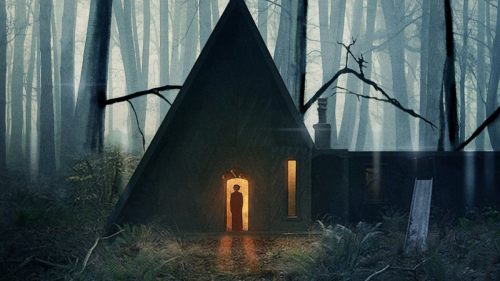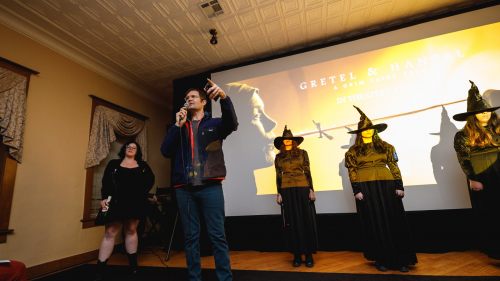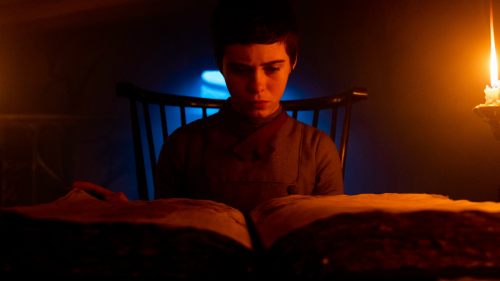“You’ll Start Seeing Things That Aren’t There”: Taking A Look At The Films Of Osgood Perkins
Gretel & Hansel is almost here. Get your tickets now!
If Osgood “Oz” Perkins’ name doesn’t seem familiar, his face might. Perkins portrayed Dorky David in 2001’s Legally Blonde, but his movie pedigree runs deep: he’s the eldest son of actor Anthony Perkins, the latter best known to horror audiences as Psycho’s Norman Bates.
As a writer and director, Perkins has already established a distinctive style with just two feature films. Both The Blackcoat’s Daughter (2015) and I Am The Pretty Thing That Lives In The House (2016) are characterized by natural light and shadow, disquieting shot composition, slowly building dread, and female-centric narratives.
The Blackcoat’s Daughter follows two simultaneous stories centered on a girls’ Catholic boarding school. Kat (Kiernan Shipka) is anxiously awaiting the arrival of her parents before spring break, while her older classmate Rose (Lucy Boynton) has purposely delayed her parents’ arrival to deal with a potential pregnancy. Meanwhile, a mysterious young woman who calls herself Joan (Emma Roberts) is en route to that same boarding school after leaving a mental health institution.
Perkins and cinematographer Julie Kirkwood (Destroyer) utilize prolonged tracking shots of empty spaces to create an atmosphere of unease. Instead of centering the two main protagonists in each shot or relying on close-ups to convey urgency, the movie frames Kat and Rose in ways that feel voyeuristic but not exploitative. Like the characters, the viewer doesn’t truly understand what is going on but is quite aware that something just doesn’t feel right, a suspicion that only intensifies as the film continues.
Perhaps the most memorably frightening scene takes place when Rose hears strange noises emanating from the heater in the school bathroom. Rose takes a trip downstairs to a dark, spooky basement and peers through a door to see Kat kneeling in front of the furnace and bowing up and down in an unnatural manner. It’s incredibly chilling and instead of revealing more, only serves to exacerbate an already eerie situation.
What makes this scene - and indeed all of The Blackcoat’s Daughter - an exceptional addition to the horror genre is its deceptively mundane quality. Anyone who has been frightened by odd noises or seen things they can’t quite explain (but which are also too disturbing to investigate further) will relate. When violence does occur it is gruesome and unsparing, a shocking counterpart to the film’s overall languid pacing.
I Am The Pretty Thing That Lives In The House has a similar tone to The Blackcoat’s Daughter but is even more of a slow burn. Instead of the ominous, shadowy institutional vibe of its predecessor, however, it possesses an ominous, shadowy old house vibe. There are more painstakingly slow, repeated tracking shots and decentered framing of the main protagonists, but this time, open spaces and empty windows seem to beg for one’s attention, despite the fact that nothing ever pops up to provide jump scares. By drawing the viewers’ eyes to these red herrings, Perkins allows subsequent scenes of terror to have a greater effect.
Ruth Wilson plays Lili Saylor, a hospice nurse who has been hired to care for author Iris Blum (Paula Prentiss) during her final days. Blum’s home was built in the early 19th century, an aspect that would be enough to give anyone the creeps. Blum is also a horror author in the vein of Shirley Jackson (The Haunting of Hill House) and Charlotte Gilman (“The Yellow Wallpaper”), something that makes self-professed scaredy-cat Lili hesitant to read her books.
The unsettling things Lili encounters are so subtle as to be easily explained away: a phone cord pulled too tightly, a muffled knocking sound, a mildewed patch on the wall. Miss Blum hardly speaks nor does she seem to notice that anything is amiss, both of which posit Lili as an unreliable narrator. This becomes more apparent when Lilii is washing fresh-picked blackberries and imagines that her hands and forearms are swollen and mottled with black and purple stains, much like the mildew on the wall, only to realize that it’s just her imagination run amok. So is Lili actually seeing these things or is she just letting her easily-spooked imagination run wild? The ending of the film, which feels as unnerving as it does inevitable, recalls haunted house movies like Burnt Offerings, in which the house itself contains a sickness that infects its residents.
Gretel & Hansel, Perkins’ latest feature, seems to be another example of Perkins foregrounding the female perspective in his movies. He explains that he purposely inverted the two names in the well-known fairy tale on which the film is based because he wanted “more of a feeling like Gretel having to take Hansel around everywhere she goes, and how that can impede one's own evolution, how our attachments and the things that we love can sometimes get in the way of our growth."
While Perkins’ first two films deal with the legacy of death and evil, Gretel & Hansel is a story of death and evil (and cannibalism) that has been around since at least 1812 when it was published by the Brothers Grimm.
The film’s trailer is quite sumptuous and otherworldly and the cast is impressive, including Sophia Lilles (It) and genre veteran Alice Kreig (the Borg Queen in Star Trek: First Contact).
Perkins did not write the script for this film (it was adapted by Rob Grant) nor is he working with the same crew. As a result, the trailer looks and feels markedly different from his other movies. In addition, here the supernatural elements aren’t just implied, they are integral to the story itself. It will be fascinating to see how Perkins’ visual sensibilities play out in a film with not only an expanded setting but also a bigger budget, and whether Gretel & Hansel will propel him towards bigger genre film success.



